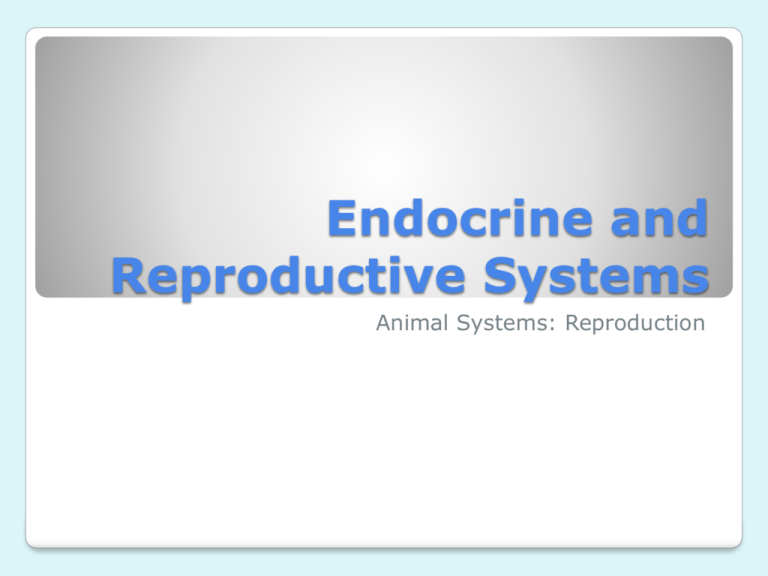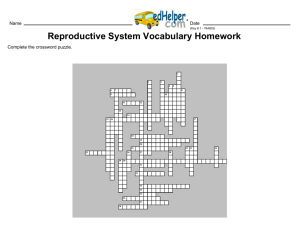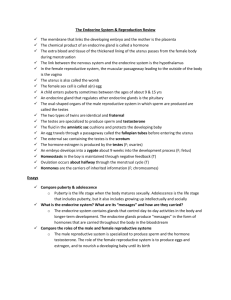Endocrine and Reproductive Systems
advertisement

Endocrine and Reproductive Systems Animal Systems: Reproduction Endocrine System: Function: The endocrine system regulates long-term changes in the body such as growth and development. It is made up of glands that release their products into the bloodstream. It also controls many of your body’s daily activities STRUCTURE HORMONES– chemicals released in one part of the body that travel through the bloodstream and affect the activities of cells in other parts of the body. • Hormones bind to specific chemical receptors on cells. • Cells that have receptors for a particular hormone are called target cells. • If a cell does not have receptors or the receptors do not respond to a particular hormone, the hormone has no effect on it. • You can think of a hormone as a chemical messenger Glands Gland – Organ that produces and releases a substance, or secretion. Two Types of Glands: ◦ Exocrine Glands – Release secretions directly to the organs that use them through ducts or tube-like structures. ◦ Endocrine Glands – Release hormones directly into the bloodstream. 1. Pituitary Gland ie. Master Gland Function: controls other endocrine glands and regulates growth rate, reproduction, and metabolism. -produces Human Growth Hormone Disorders: Too much growth hormone can result in a condition called gigantism. 8 ft 11 in Robert Wadlow 2. Hypothalamus – regulates hunger, thirst, sleep, body temperature, and most involuntary mechanisms ◦ links the nervous system to the endocrine system via the pituitary gland. 3. Pineal gland– secretes melatonin which responds to daylight and seasonal changes (sleep/wake cycle) 4. Thymus gland - Hormones released by the thymus gland help the immune system (T-cells) develop during childhood. By adolescence, this gland has shrunk considerably in size 5. Adrenal glands - These glands release several hormones such as adrenaline (epinephrine & norepinephrine), which triggers the body’s response to sudden stress (fight or flight). Other hormones affect salt and water balance in the kidneys and general metabolism 6. Thyroid Gland Hormone: Thyroxin Function: regulates the body’s overall metabolic rate and controls calcium levels in the bloodstream Disorders: Hyperthyroidism - too much thyroxin; fast metabolism (weight loss) Hypothyroidism - too little thyroxin; slow metabolism (weight gain) 7. Pancreas - Produces insulin (lowers) and glucagon (raises) to keep the blood sugar level constant. * Disorders: Diabetes disease in which the pancreas fails to produce insulin or the body does not properly use Insulin 8. Ovary - The female reproductive glands release sex hormones that regulate egg maturation and control the development of 2nd sex characteristics (estrogen, progesterone) * breast development; widen hips 9. Testes - The male reproductive glands release a sex hormone that regulates sperm production and controls the development of 2nd sex characteristics (testosterone) * facial hair growth; voice deepen Some Hormones And Their Functions 1.Antidiuretic Hormone (ADH): Decrease the amount of water absorbed by the kidneys 2. Insulin & Glucagon: Regulate blood sugar levels 3. Follicle Stimulating Hormone (FSH): Stimulates the growth/maturation of gametes The Endocrine system working with other body systems… Nervous System: Hormones provide feedback to the Reproductive System: hormone production for Muscular and Skeletal System: endocrine system Immune System: the development is controlled by Digestive System: The endocrine system controls the brain to affect neural processing. sexual development to make offspring controls the growth of both bone and muscles the endocrine system rate of metabolism Reproductive System: Purpose: The reproductive system combines genetic information from both parents (in most animals) to produce new life forms. This system produces sex cells (gametes), delivers them, and protects a developing fetus until birth. Comparing Reproductive Systems Asexual Sexual Involves one parent. As a result, the offspring tend to have the same genotype and phenotype as the parent. involves the fusion of two gametes. Sperm and eggs are sometimes produced by the same individual and sometimes produced by different individuals. Ex: Flatworms can divide into 2 halves; each half grows into a separate organism. Cnidarians undergo budding where a new individual grows from and then breaks off of the parent individual. Ex: Vertebrates Genetically identical Genetic variation There are 2 major mechanisms of fertilization external fertilization: Used by many aquatic invertebrates. Eggs and sperm are simultaneously shed into the water, and the sperm swim through the water to fertilize the egg internal fertilization: The eggs are fertilized within the reproductive tract of the female, and then are covered with egg shells and/or remain within the body of the female during their development Comparative Reproductive Systems In most animals, individuals are either definite males or females; however some species are hermaphrodites. This is when one organism produces both egg and sperm. Ex: earthworms and garden snails Parts of the Reproductive System **Gametes: Specialized sex cells (sperm and egg) Male 1. Penis - External sex organ, delivers sperm to female Male Reproductive System The main organs of the male reproductive system are the testis. The testis remain in the scrotum (external sac) outside the body cavity, where the temperature is about 1-3⁰ lower than the normal temperature of the body. Lower temperature is important for proper sperm development. Male urethra- carries sperm and urine through and out the penis Sperm Development 1. 1. 1. Sperm production resulting from testosterone & meiosis is in the seminiferous tubules. Fully mature sperm are stored in the epididymus in between ejaculations. From the epididymus, some sperm are moved into a tube called the vas deferens. 2. Extends upward from the scrotum into the abdominal cavity. Vas deferens merges with the urethra, the tube that leads to the outside of the body through the penis. Flow of sperm: seminiferous tubules epididymusvas deferensurethra Semen Glands (Prostate- neutralizes acids, Cowper’s lubricant, Seminal vesicle- nutrient) lining the reproductive tract produce a nutrient- rich fluid called seminal fluid. Seminal fluid nourishes the sperm and protects them from the acidity of the female reproductive tract. Combination of sperm and seminal fluid is known as semen. 2.5 million sperm are found in one drop of semen! If sperm are released in the reproductive tract of a female, the chances of a single sperm fertilizing an egg, if one is available, is quite good. Female Parts of the Reproductive System 1. OvariesThe primary organs in the female reproductive systems; the female gametes (ova or egg) 2. Fallopian Tubes - Transport egg to uterus 3. Uterus – Organ where fertilized egg develops 4. Vagina - Birth canal If the egg implants… The fetus will develop in the muscular organ called the uterus. After the fetus is fullterm, a woman goes into labor. At this time the cervix, a muscular ring between the uterus and the vagina, will dilate allowing the baby to pass through. http://www.youtube.com/watch?v=1IDRIdE05ko (elephant birth) healthy cervix (above), baby in uterus (below) Parts of the Reproductive System Female 5. Placenta - serves for gas exchange and metabolic products with mother 6. Umbilical cord- attaches embryo to placenta 7. Amniotic fluid - keeps the embryo moist and protected Placenta Facts About the Female Menstrual Cycle The cycle takes an average of 28 days. Regulated by hormones produced by the endocrine system, such as estrogen and progesterone. Begins at puberty and continues until menopause. Permanent stopping of the menstrual cycle is called menopause. Average age for menopause is about 51, but can occur anytime between the late thirties and late fifties. Day 1-5: If fertilization does not occur within 2-3 days, the unfertilized egg passes through the uterus without implanting. The uterine lining detaches from the wall and is discharged, along with blood and the unfertilized egg through the vagina. (this is called menstruation) Day 5-14: uterine lining thickens, preparing to receive a fertilized egg Day 14: release of a mature egg into the fallopian tube. (this is called ovulation) Day 14-28: The first 3-4 days of this stage, the chance of fertilization is highest. Female Reproductive Cycle Phases of the Menstrual Cycle 1. Follicular Phase 2. Ovulation 3. Luteal Phase 4. Menstruation View the following animation: http://www.knowmycycle.com/cycle-closer.aspx Endometriosis When tissue from the uterus is found growing OUTSIDE the uterus (ex. on the ovaries) Treatment: attempts to remove endometrial tissue and preserving the ovaries without damaging normal tissue The Reproductive system working with other body systems… Nervous System: Reproductive hormones affect brain development and sexual behavior. ◦ The brain controls mating behavior Endocrine System: Endocrine Glands produce hormones (ovary and testis) 1st Trimester (3 mo.) 2nd Trimester (3-6 mo.) 1st Trimester (3 mo.) 2nd Trimester (3-6 mo.)






